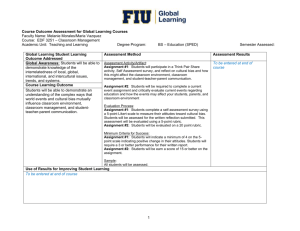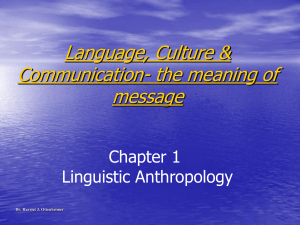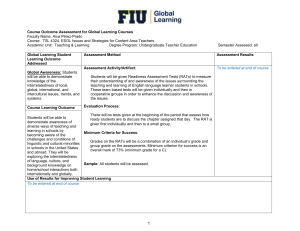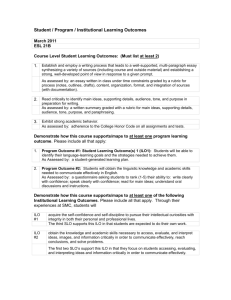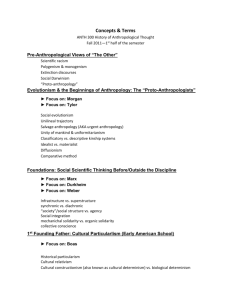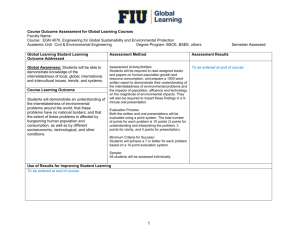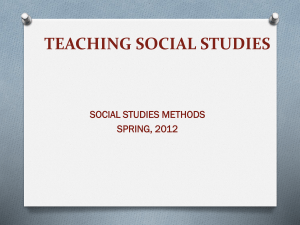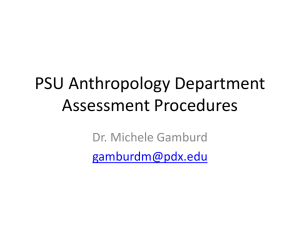Matrix - FIU Global Learning
advertisement
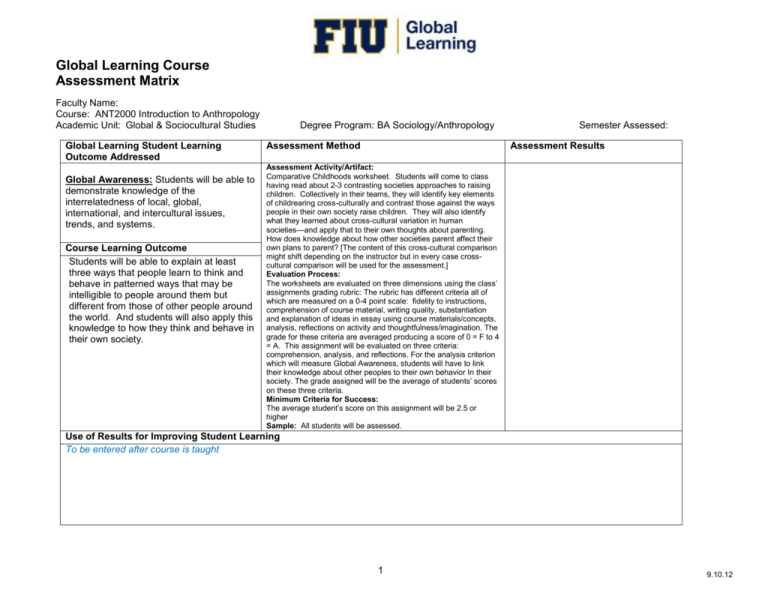
Global Learning Course Assessment Matrix Faculty Name: Course: ANT2000 Introduction to Anthropology Academic Unit: Global & Sociocultural Studies Global Learning Student Learning Outcome Addressed Global Awareness: Students will be able to demonstrate knowledge of the interrelatedness of local, global, international, and intercultural issues, trends, and systems. Course Learning Outcome Students will be able to explain at least three ways that people learn to think and behave in patterned ways that may be intelligible to people around them but different from those of other people around the world. And students will also apply this knowledge to how they think and behave in their own society. Degree Program: BA Sociology/Anthropology Assessment Method Semester Assessed: Assessment Results Assessment Activity/Artifact: Comparative Childhoods worksheet. Students will come to class having read about 2-3 contrasting societies approaches to raising children. Collectively in their teams, they will identify key elements of childrearing cross-culturally and contrast those against the ways people in their own society raise children. They will also identify what they learned about cross-cultural variation in human societies—and apply that to their own thoughts about parenting. How does knowledge about how other societies parent affect their own plans to parent? [The content of this cross-cultural comparison might shift depending on the instructor but in every case crosscultural comparison will be used for the assessment.] Evaluation Process: The worksheets are evaluated on three dimensions using the class’ assignments grading rubric: The rubric has different criteria all of which are measured on a 0-4 point scale: fidelity to instructions, comprehension of course material, writing quality, substantiation and explanation of ideas in essay using course materials/concepts, analysis, reflections on activity and thoughtfulness/imagination. The grade for these criteria are averaged producing a score of 0 = F to 4 = A. This assignment will be evaluated on three criteria: comprehension, analysis, and reflections. For the analysis criterion which will measure Global Awareness, students will have to link their knowledge about other peoples to their own behavior In their society. The grade assigned will be the average of students’ scores on these three criteria. Minimum Criteria for Success: The average student’s score on this assignment will be 2.5 or higher Sample: All students will be assessed. Use of Results for Improving Student Learning To be entered after course is taught 1 9.10.12 Global Learning Course Assessment Matrix Faculty Name: Course: ANT2000 Introduction to Anthropology Academic Unit: Global & Sociocultural Studies Degree Program: BA Sociology/Anthropology Semester Assessed: Global Learning Student Learning Assessment Method Assessment Results Outcome Addressed Assessment Activity/Artifact: To be entered after course is taught “Beyond my cultural comforts” assignment requires Global Perspective: Students will be able students to exchange culturally discomforting experiences to conduct a multi-perspective analysis of with a classmate. That classmate will accompany the local, global, international, and intercultural other to something s/he finds culturally comfortable but problems. which will be outside the classmate’s own cultural Course Learning Outcome Students will be able to analyze their cultural discomforts and expand their cultural comforts across at least one cultural boundary. comforts and vice-versa. In written essays, students will apply course concepts to analyze how and why they felt outside their cultural comforts and what perspectives they gained by expanding their cultural horizons beyond what they take as normal. Evaluation Process: The rubric explained above (using 0-4 points for each of several criteria) will be used to evaluate the resulting essays for: fidelity to instructions, comprehension of course material, writing quality, substantiation and explanation of ideas using course materials/concepts, reflections on activity and thoughtfulness/imagination. Students’ Global Perspective will be measured through the substantiation criterion in particular, demonstrating their ability to understand their own cultural comforts and discomforts through concrete comparative examples and linkages to the course materials. This activity is heavily weighted in the student’s overall grade at 15%. Minimum Criteria for Success: The average student’s score on this assignment will be 2.5 or higher Sample: All students will be assessed. Use of Results for Improving Student Learning To be entered after each time course is taught 2 9.10.12 Global Learning Course Assessment Matrix Faculty Name: Course: ANT2000 Introduction to Anthropology Academic Unit: Global & Sociocultural Studies Degree Program: BA Sociology/Anthropology Semester Assessed: Global Learning Student Learning Assessment Method Assessment Results Outcome Addressed Assessment Activity/Artifact: To be entered after course is taught “My Career Connections” worksheet. The Global Engagement: Students will be able worksheet has students investigate careers that to demonstrate willingness to engage in those trained in anthropology pursue or in which local, global, international, and intercultural anthropological knowledge is useful. They then problem solving. discuss cultural issues they have already Course Learning Outcome Students will be able to explain at least three ways that culture affects how people view and solve problems and apply their learning to their own careers or career plans. experienced at work or which they anticipate experiencing in their careers. They then analyze how their gained anthropological knowledge will aid them in addressing these issues at work or in a career they are pursuing. Evaluation Process: The rubric explained above (using 0-4 points for each of several criteria) will be used to evaluate the resulting essays for: fidelity to instructions, analysis, reflections on activity and thoughtfulness/imagination. The analysis criterion will be the one particularly attuned to evaluating how well students can apply their global learning from the course to problems they encounter or anticipate encountering in their jobs and careers. Minimum Criteria for Success: The average student’s score on this assignment will be 2.5 or higher Sample: All students will be assessed. Use of Results for Improving Student Learning To be entered after course is taught 3 9.10.12
